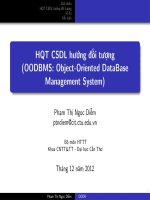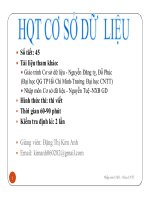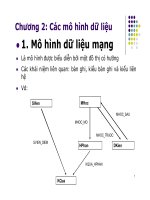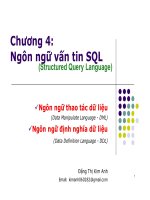Bài giảng Hệ quản trị cơ sở dữ liệu - Chương 13: Security
Bạn đang xem bản rút gọn của tài liệu. Xem và tải ngay bản đầy đủ của tài liệu tại đây (245.19 KB, 72 trang )
Chương 13
Security
1
2
11.1 Introduction to Database Security
Types of Security
– Legal and ethical issues
– Policy issues
– System-related issues
– The need to identify multiple security levels
3
11.1 Introduction to Database Security
Threats to databases
– Loss of integrity
– Loss of availability
– Loss of confidentiality
To
protect
databases,
four
kinds
countermeasures can be implemented:
– Access control
– Inference control
– Flow control
– Encryption
of
4
11.1 Introduction to Database Security
A DBMS typically includes a database security
and authorization subsystem that is responsible
for ensuring the security portions of a database
against unauthorized access.
Two types of database security mechanisms:
– Discretionary security mechanisms
– Mandatory security mechanisms
5
11.1 Introduction to Database Security
The security mechanism of a DBMS must include
provisions for restricting access to the database as
a whole
– This function is called access control and is
handled by creating user accounts and
passwords to control login process by the
DBMS.
6
11.1 Introduction to Database Security
The security problem associated with databases is
that of controlling the access to a statistical
database, which is used to provide statistical
information or summaries of values based on
various criteria.
– The countermeasures to statistical database
security problem is called inference control
measures.
7
11.1 Introduction to Database Security
Another security is that of flow control, which
prevents information from flowing in such a way
that it reaches unauthorized users.
Channels that are pathways for information to flow
implicitly in ways that violate the security policy of
an organization are called covert channels.
8
11.1 Introduction to Database Security
A final security issue is data encryption, which is
used to protect sensitive data (such as credit card
numbers) that is being transmitted via some type
communication network.
The data is encoded using some encoding
algorithm.
– An unauthorized user who access encoded data
will have difficulty deciphering it, but
authorized users are given decoding or
decrypting algorithms (or keys) to decipher
data.
11.2 Access Control
9
A DBMS offers two main approaches to access
control.
Discretionary access control is based on the
concept of access rights, or privileges, The
mechanisms for giving users such privileges.
– A privilege allows a user to access some data
object in a certain manner
– SQL-92 supports discretionary access control
through the GRANT and REVOKE commands.
11.2 Access Control
10
• The GRANT command gives privileges to
users,
• The REVOKE command takes away privileges
Mandatory access control is based on
systemwide policies that cannot be changed by
individual users. In this approach
– Each database object is assigned a security class.
– Each user is assigned for a security class, and
rules are imposed on reading and writing of
database objects by users.
11
11.3 Discretionary Access Control
SQL-92 supports discretionary access control
through the GRANT and REVOKE commands.
The GRANT command gives users privileges to
base tables and views.
– The syntax:
• With object is either a base table or a view
12
11.3 Discretionary Access Control
The account level:
– At this level, the DBA specifies the particular
privileges
that
each
account
holds
independently of the relations in the database.
The relation level (or table level):
– At this level, the DBA can control the privilege to
access each individual relation or view in the
database.
13
11.3 Discretionary Access Control
The privileges at the account level apply to the
capabilities provided to the account itself and can
include
– The CREATE SCHEMA or CREATE TABLE
privilege, to create a schema or base relation;
– The CREATE VIEW privilege;
– The ALTER privilege, to apply schema changes
such adding or removing attributes from
relations
14
11.3 Discretionary Access Control
– The DROP privilege, to delete relations or
views;
– The MODIFY privilege, to insert, delete, or
update tuples;
– And the SELECT privilege, to retrieve
information from the database by using a
SELECT query.
15
11.3 Discretionary Access Control
The second level of privileges applies to the
relation level
– This includes base relations and virtual (view)
relations.
The granting and revoking of privileges generally
follow an authorization model for discretionary
privileges known as the access matrix model
where
16
11.3 Discretionary Access Control
– The rows of a matrix M represents subjects
(users, accounts, programs)
– The columns represent objects (relations,
records, columns, views, operations).
– Each position M(i,j) in the matrix represents
the types of privileges (read, write, update) that
subject i holds on object j.
17
11.3 Discretionary Access Control
To control the granting and revoking of relation
privileges, each relation R in a database is assigned
and owner account, which is typically the account
that was used when the relation was created in the
first place.
– The owner of a relation is given all privileges on
that relation.
18
11.3 Discretionary Access Control
– In SQL2, the DBA can assign and owner to a
whole schema by creating the schema and
associating the appropriate authorization
identifier with that schema, using the CREATE
SCHEMA command.
– The owner account holder can pass privileges
on any of the owned relation to other users by
granting privileges to their accounts.
19
11.3 Discretionary Access Control
In SQL the following types of privileges can be
granted on each individual relation R:
– SELECT (retrieval or read) privilege on R:
• Gives the account retrieval privilege.
• In SQL this gives the account the privilege to
use the SELECT statement to retrieve tuples
from R.
– MODIFY privileges on R:
• This gives the account the capability to
modify tuples of R.
20
11.3 Discretionary Access Control
• In SQL this privilege is further divided into
UPDATE, DELETE, and INSERT privileges to
apply the corresponding SQL command to R.
• In addition, both the INSERT and UPDATE
privileges can specify that only certain attributes
can be updated by the account.
– REFERENCES privilege on R:
• This gives the account the capability to reference
relation R when specifying integrity constraints.
• The privilege can also be restricted to specific
attributes of R.
21
11.4 Specifying Privileges Using Views
The mechanism of views is an important
discretionary authorization mechanism in its own
right. For example,
– If the owner A of a relation R wants another
account B to be able to retrieve only some fields
of R, then A can create a view V of R that
includes only those attributes and then grant
SELECT on V to B.
22
11.4 Specifying Privileges Using Views
– The same applies to limiting B to retrieving only
certain tuples of R; a view V’ can be created by
defining the view by means of a query that
selects only those tuples from R that A wants to
allow B to access.
11.5 Revoking Privileges
23
In some cases it is desirable to grant a privilege to
a user temporarily. For example,
– The owner of a relation may want to grant the
SELECT privilege to a user for a specific task
and then revoke that privilege once the task is
completed.
– Hence, a mechanism for revoking privileges is
needed. In SQL, a REVOKE command is
included for the purpose of canceling
privileges.
11.5 Revoking Privileges
24
The REVOKE command: withdrawal privileges
Syntax:
– CASCADE: withdraw the privileges from all
users who currently hold these privileges
through a GRANT command that was previously
executed by the same user who is now
executing the REVOKE command.
11.5 Revoking Privileges
25
• If these users received the privileges with the
grant option and passed it along, those
recipients will also lose their privileges as a
consequence of the REVOKE command
unless they also received these privileges
independently
– RESTRICT command is rejected if revoking the
privileges just from the users specified in the
command would result in other privileges
becoming abandoned.









